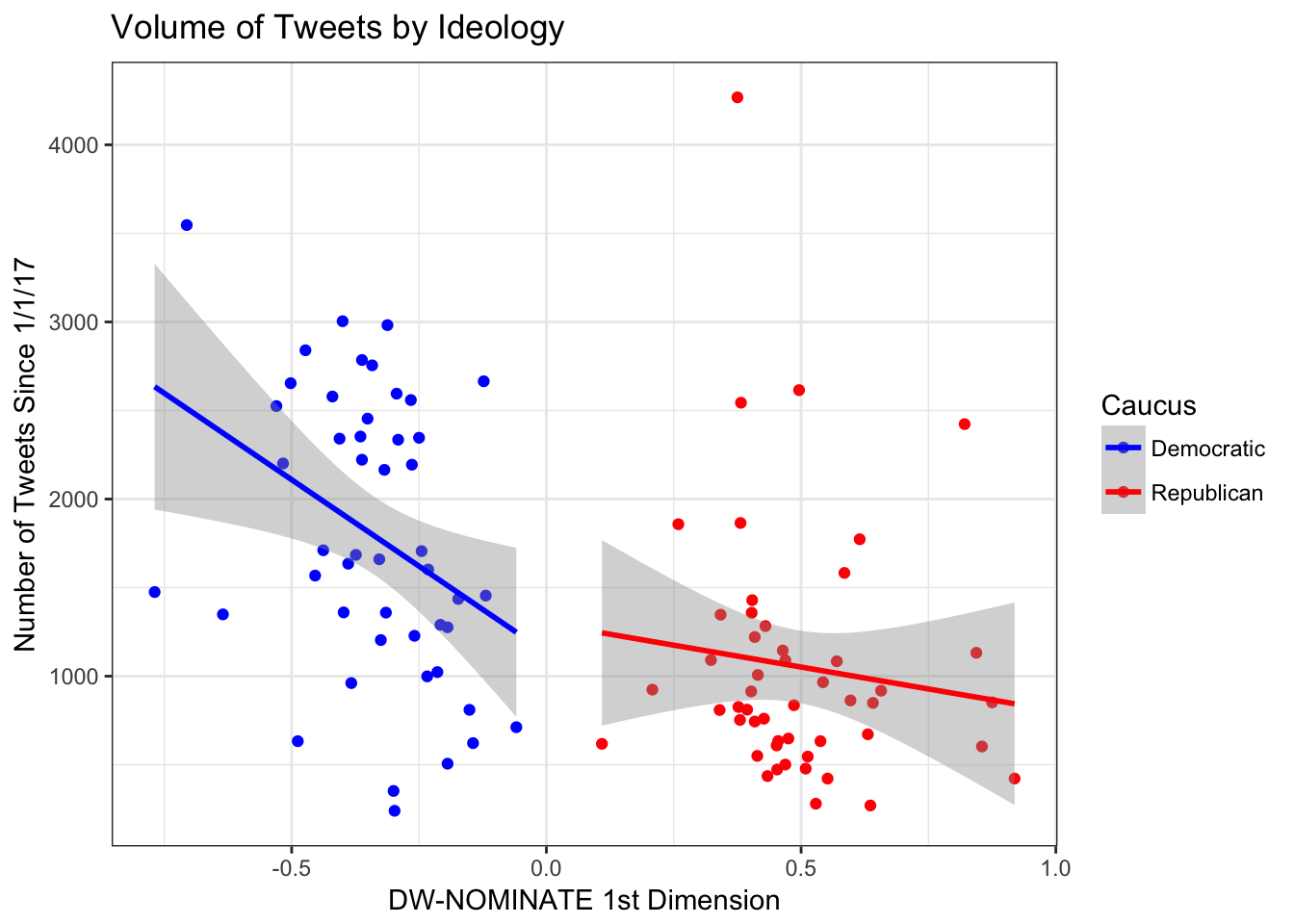Senator Ideology and Engagement Rates on Twitter
Jon Green
May 3, 2018
Abstract
As part of Data for Progress’s continuing analysis of how politicians and the public interact on Twitter, this short research note investigates the relationship between ideology and engagement rates. In line with earlier work, which found that more ideological senators have wider reach on Facebook, I find that more ideological senators receive more likes and retweets per tweet they send – but that these trends are largely driven by a handful of senators with particularly strong ideologies and particularly high engagement rates.
Recent analyses from Pew have found that more ideological Senators have larger audiences on Facebook, are more likely to share content that highlights conflict with the opposing party, and that content that highlights disagreement with or anger at the opposing party generates higher social media engagement. Importantly, rather than finding a uniform trend across the board, Pew reported that their findings were largely driven by a handful of strong ideologues.
There are good reasons to expect patterns like these to emerge. Politically attentive citizens are, almost by definition, more likely to pay attention to what politicians are communicating on social media. And citizens who pay closer attention to politics have generally been found to, on average, have more ideologically coherent sets of attitudes. Taken together, this suggests that politicians’ social media accounts attract politically attentive and disproportionately ideological social media users, who are more likely to consume and share politically polarizing content. Highly ideological senators who command national attention, such as Bernie Sanders or Ted Cruz, should be expected, then, to have larger social media followings and generate a high amount of engagement on their social media communications.
In this post, I extend Pew’s analysis to Twitter, using a dataset of all current U.S. senators’ tweets sent between January 1, 2017 and April 18, 20181. All of the reasons we might expect ideological senators to have wider reach on Facebook are even more true for Twitter. In a 2016 survey, 79 percent of Internet-using U.S. adults (representing 68% of all U.S. adults) reported using Facebook, while only 24 percent said they were on Twitter. And if the United States is anything like the UK, the site of a recent study of the demographic composition and political behavior of Twitter users, that smaller share is likely to be younger, more politically attentive, and more liberal than the general public.
While Pew focused on the number of followers a given senator had, conditional on ideology, I instead focus here on engagement rates. How many retweets and favorites should we expect a senator’s tweet to receive, based on how ideological their voting record is?
We begin by plotting bivariate relationships between ideology – measured here using DW-NOMINATE, a standard measure in political science – and relevant Twitter metrics. First, we simply look at how many tweets each senator sent during our time range.
As we can see, there is a clear – albeit noisy – relationship between ideology and tweet volume among Democrats, with more ideological members tweeting more often. However, there is no such relationship among Republicans. Next, we turn to favorite rates: the average number of favorites each senator received per tweet they sent. As the distribution of favorite rates is highly skewed, we represent it with a log scale.
Again, we find a clearer relationship between ideology and our outcome of interest among Democrats than Republicans, although in this case Republicans’ favorite rates do increase as their DW-NOMINATE scores move away from zero. In both caucuses, this trend seems to be driven by a few extreme cases. When the five most ideological senators are removed from each caucus, the trends observed in the full set do not emerge.
As both represent positive engagements, favorites are highly correlated with retweets. As such, we observe a similar pattern when we examine retweet rate by ideology. Overall, more distance from zero on the DW-NOMINATE scale predicts higher engagement, but the trends are driven by a few highly ideological senators.
Next, I specify ordinary least squares regressions predicting logged favorite and retweet rates by ideological extremity, controlling for caucus.
In both of these models, I find that a one-unit increase in the absolute value of DW-NOMINATE, which in this case is equivalent to spanning the whole range of the scale, is associated just under a 105105 unit increase in the number of favorites and retweets a given senator should expect to receive per tweet, holding all else constant. Visualizing these relationships below shows how these predicted outcomes change for hypothetical senators of varying ideological orientations.
Finally, I find that these higher positive engagement rates translate into lower average ratios – defined as the number of comments a senator receives for every like on their tweets. While Republicans are ratio’d much more often on average than Democrats, more centrist members of both caucuses receive more comments per like than their more ideological counterparts.
In general, these findings confirm the earlier Pew analyses, showing that more ideological senators see higher engagement rates on Twitter, but that these trends are largely driven by a small handful of strong ideologues. Further analysis is needed to show whether these higher-engaging tweets are themselves more ideological – perhaps more centrist senators tweet more about local issues, which are less likely to attract a national audience. In any case, we can safely say that an era when likes equal respect and retweets equal endorsement is no era for centrists.
Unless otherwise noted, Doug Jones will be excluded from this analysis, having sent less than 100 tweets as a U.S. senator during this time period. For the purposes of sorting senators by party, we include independents Bernie Sanders and Angus King in the Democratic caucus.






